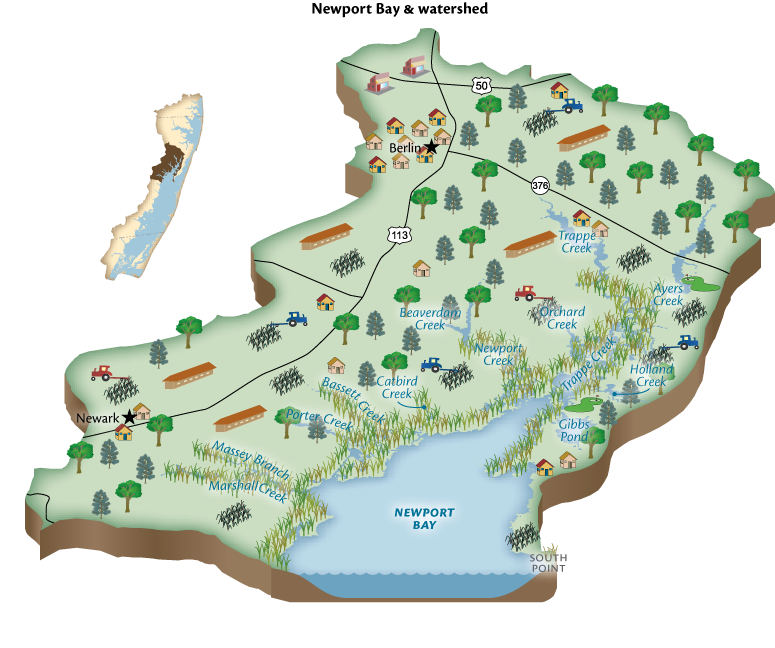
General Description
Newport Bay watershed includes the town of Berlin, the western half of South Point, the village of Newark, and extensive farms and forest to just south of Langmaid Road. Ayres Creek, Kitts Branch, Trappe Creek, Newport Creek, and Marshall Creek are the primary tributaries that feed Newport Bay. Newport Bay watershed contains extensive marshes, farms, and forest; over one third of the watershed is forested. Ayres Creek headwaters contains extensive forested wetlands that are important habitats along the Atlantic flyway.
Ecosystem Health Ranking
- Ranks 5 out of 5
- 2021 Maryland Coastal Bays Report Card
Challenges
The community of South Point is entirely served by individual septic systems—763 septic systems are within 1,000 feet of surface water in the Newport Bay watershed. Septic systems contribute nitrogen to shallow ground water and eventually to surface waters. In addition, non-point sources of pollution include lawns and impervious surfaces (rooftops, roads, etc.).
Inadequate stormwater management in the Town of Berlin has led to flooding, particularly in the Bottle and Kitts Branch subwatersheds, even during minor rain events. Poorly managed stormwater also releases pollutants to waterways during rain events.
Extensive mosquito ditches are present throughout the bay’s tidal wetlands, compromising natural function and accelerating damage due to sea level rise.
Agricultural activities such as tillage and the application of manure/poultry litter/chemical fertilizer/pesticides can contribute pollution to our waterways, and in Newport Bay watershed it is the largest contributor of nutrient pollution. There are approximately two dozen poultry operations and over 7,000 acres in crop production in Newport Bay watershed.
Key Current Solutions
Pre-treatment technologies treat wastewater before it reaches the drainfield of septic systems. The state’s Bay Restoration Fund provides grants to either connect septic systems to public sewer or install nitrogen-removing pre-treatment to an existing system, cutting its nitrogen contributions to groundwater in half.
In 2013 the Town of Berlin established a Stormwater Utility Department and authorized collection of a Stormwater Utility fee from every property ($50 annually) to fund stormwater management improvements. Six projects have been completed including culvert replacement, wetlands, storm drain replacement, channel stabilization and restoration, partly with assistance from grants.
Protection of headwaters—the lands and water and the top of the watershed—is important for protecting water quality. The Holly Grove swamp, the headwaters of Ayres Creek, contains hundreds of acres of contiguous woodland and provides abundant wildlife habitat and well as water quality benefits; and it is the last large contiguous piece of woodland remaining adjacent to Ocean City. MCBP, Worcester County, and the state of Maryland worked together to acquire and restore the 430-acre Ilia Fehrer Nature Preserve (located on Assateague Road). The property is owned by Worcester County and managed by MCBP.
Conservation practices, often referred to as BMPs (Best Management Practices), are implemented on farms. These include conservation tillage, cover crops, forest buffers, and other practices. Over half the cropland in the watershed is placed in cover crops annually. Farmers also implement various other practices with support from USDA and the state’s Soil Conservation Service that reduce non-point source pollution.
How You Can Help
- Plant native trees and other plants on your property
- Reduce or eliminate use of fertilizer
- Clean up after your pet
- Reduce travel by vehicle—combine trips or walk/bike
- Learn about the watershed you live in and its natural resources—volunteer, visit a park or attend informational events about the coastal bays
- Install a rain barrel or a rain garden to treat stormwater
- Get your septic system pumped regularly and ensure it is working optimally
- Enhance your shoreline with native species and eliminate invasive non-native species such as Phragmites
